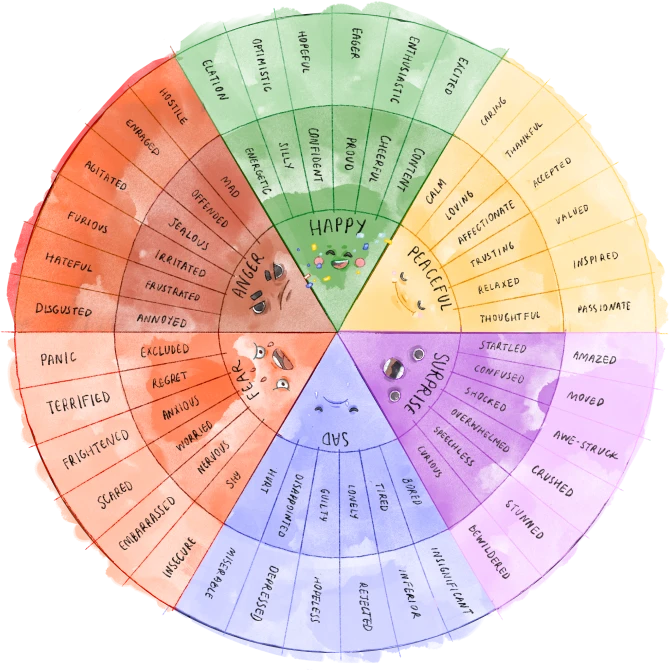Why do people become irritable and snap at their loved ones? One reason is that they suppress their feelings, which may negatively impact their emotional balance [1]. Learning how to feel your feelings may help you understand your desires, needs, and values.
Understanding your emotions is part of having emotional intelligence. Let’s figure out how emotional intelligence influences our lives and how to feel our feelings instead of intellectualizing them.
Want to understand your emotions better and get valuable insights into how you express them? Take the Emotional Intelligence test!
What Are Feelings and Emotions?
According to the American Psychological Association (APA), emotions are complex reactions involving thoughts, physical responses, and behaviors [2].
Emotions arise when we deal with things that are personally important to us. They have three parts: how we experience them, how our body reacts, and how we express them. Feelings, in turn, are similar to physical sensations like hunger or pain, but they come from our emotional experiences. They can also be influenced by memories, beliefs, or other factors.
If you want to figure out how to feel your feelings and learn more about your emotional tendencies in a fun way, take our “What emotion am I?” quiz.
A mood is also an important concept associated with feelings and emotions. It is a more general emotional state that lasts a while but isn’t as intense as an emotion and doesn’t always have a clear trigger. For example, you might feel grumpy all day without any obvious reason.
Why Processing Emotions Is Important?
Emotions are signals, not problems. They may tell you something important is going on, even if it feels uncomfortable. At the same time, processing emotions can help you reveal your needs, boundaries, and desires. So, if you wonder how to feel your feelings instead of intellectualizing them, here are the main benefits:
- Build Deep Relationships With Others. When you let yourself feel and share your emotions, it can help you connect with people, be emotionally available, and build trust [3].
- Boosts Self-Awareness: Understanding your emotions helps you react more thoughtfully, not impulsively, to situations in life [4].
- Encourages Personal Growth: Facing your emotions head-on helps you learn and grow from difficult experiences, making you more open-minded and empowered in the future [5].
“It’s important to feel your emotions because they help you understand yourself, as well as the world around you. They signify something important. Your emotions help you understand and express your needs. They also motivate you to take action and give you a sense of purpose“. – Emily Mendez, M.S., Ed.S.
Why Suppressing Emotions Is Bad?
Suppressing emotions may seem like an easy way to avoid discomfort, but it can actually lead to long-term harm. When you don’t look for a way to process emotions, they don’t go away—they build up and can show up and affect your emotional balance or cause physical symptoms, which is called “somatization.” Somatization may present as headaches, muscle tension, fatigue, back pain, gastrointestinal problems, or insomnia [1].
We asked Emily Mendez, M.S., Ed.S., why suppressing emotions is bad.
Resist the urge to bottle up your emotions. Numerous studies have shown that, in the long run, suppressing your feelings is harmful to your mental health. If you ignore your emotions, they will come out later in a way that may not be healthy. It’s important to acknowledge and respond to your emotions.
7 Ways on How to Feel Your Feelings
Learning how to feel emotions can be tricky, especially if you’ve been used to avoiding or intellectualizing them. However, processing emotions truly is a step toward emotional balance. Here are some simple steps on how to feel your feelings more deeply and authentically:
1. Let Yourself Feel
One of the biggest obstacles to learning how to feel your feelings instead of intellectualizing them is the belief that some emotions are “bad” or “wrong.” The truth is all emotions are valid.
That’s why letting yourself feel without judgment allows you to experience the full range of human emotions. When you feel something, don’t criticize yourself for having that emotion. Just acknowledge that it’s part of being human.
If you’re feeling sad after an argument, instead of thinking, “I shouldn’t be feeling this way,” remind yourself that it’s okay to feel sad and you’re just processing emotions.
2. Name Your Feelings
If you wonder how to feel emotions, try naming what you’re experiencing to separate the feeling from your thoughts and understand the root of the emotion.
The RAIN 4-step mindfulness technique may help you respond to your feelings with more awareness and control, making processing emotions easier:
1. Recognize
Ask yourself, “What exactly am I feeling?” It could be sadness, anger, excitement, jealousy, or even relief. Be specific. Instead of saying, “I’m upset,” try something more precise. It may be “I’m feeling disappointed” or “I’m feeling misunderstood.”
Try to describe what you’re experiencing as clearly as you can. You can even use a metaphor or comparison to really understand its depth.
Take a moment to check in with yourself and put a name to the emotion using the Feelings Wheel below.

2. Accept
If you’re feeling guilty about something, try saying, “It’s okay to feel guilty” instead of harshly criticizing yourself. I can learn how to process emotions from this and move forward.”
In this case, self-compassion can make you feel less vulnerable and more capable of dealing with things like failure or being wrong [4]. You’re not broken for processing emotions; you’re just human.
3. Investigate
Get curious about the emotion to understand the full range of what you’re experiencing. Ask yourself:
- Where did this come from?
- What was I thinking before I felt this way?
- What’s behind this feeling—what is this emotion trying to tell you?
4. Not Identify
Remember, you are not your emotions. You’re experiencing them, but they don’t define you. Emotions come and go, and it’s helpful to see them as passing visitors instead of permanent parts of who you are. You can observe, feel, and learn from them—but you don’t have to become them.
3. Check In With Your Body When You Are Processing Emotions
When things are getting intense and you think about how to process emotions, deep breathing is a way to stay connected to the present moment. It can also calm your nervous system so you can feel your emotions without being swept away by them [6].
Try a few deep breaths: inhale slowly for four counts, hold for four, and exhale for four. Do this a few times until you feel more centered.
Paying attention to your body signals can help you identify what’s going on emotionally and how to feel your feelings.
You’re about to meet someone new, and you feel tightness in your chest. This could signal you’re worried about the upcoming social interaction. Or, after hearing a touching story from a friend, you feel a lump in your throat. It might be a sign that you’re moved or emotionally affected.
You can also try the following visualization exercise for processing intense emotions and releasing them:
- Sit in a comfortable position, close your eyes, and take several deep breaths.
- Imagine that with each exhale, the emotions you are uncomfortable with are leaving your body. Picture them flowing out or disappearing.
- Visualize the negative emotions leaving through your feet or hands, taking away tension.
- Feel how your body is being freed from this tension and returning to a state of calm.

4. Express Your Feelings
Once you’ve identified and felt your emotions, try to express them. It can be the next step toward understanding how to process emotions. Holding them inside can make them feel heavier, but sharing them with others can provide relief.
Talk to someone you trust about what you’re feeling. You could also express yourself through writing using journal prompts, art, or music.
5. Give Yourself Space and Time For Processing Emotions
When you feel that your emotions are intense, try to go for a walk, take a nap, or do something that soothes you. Just give yourself time to figure out how to feel your feelings before acting on it.
For instance, if you’re feeling tired or irritated at work, take a few minutes to relax before responding to an email or making a decision. This may give your emotions space to settle so you can deal with the situation calmly.
The UK National Health Service offers a STOPP technique for processing emotions when you’re feeling worried [7]:
- Stop!
Take a moment to pause. Just say “STOP” in your head when you feel concerned or triggered.
- Take a breath
Breathe slowly and deeply. Inhale through your nose, and exhale through your mouth. Focus on your breath.
- Observe
Notice what’s happening in your mind and body:
- What thoughts are going through your mind right now?
- What are you reacting to?
- What sensations do you notice in your body?
- Pull back – put things in perspective
Remember, thoughts are just thoughts—not facts. You don’t have to believe everything your mind is telling you. That’s why you should tell yourself:
- What’s the bigger picture?
- What is another way of looking at this situation?
- What advice would I give a friend?
- This will pass
- Practice what works – then proceed
Ask yourself:
- What is the best thing to do right now?
- What is the most helpful thing for me, for others, for the situation?
- What can I do that fits with my values?
- Where can I focus my attention right now?
Do what will be effective and appropriate.
6. Use Creative Outlets
Another way to understand how to feel feelings is to pick an activity that feels natural to you. It doesn’t have to be perfect—just let your emotions flow.
If you’re feeling tense but you’re thinking about how to feel your emotions, try writing about it in a journal or sketching how it feels. Eventually, your creative expression may help you understand how to process emotions and how to be the best version of yourself.
7. Reflect on What You Need While Processing Emotions
Our emotions may point to unmet needs [5]. For instance, if you feel sad, it may be because you need comfort or support. Thus, you can ask yourself, “What do I need right now?” It might be a break, a conversation, or some time alone. For example, if you’re feeling worried about a big decision, you might realize that what you need is reassurance or information to feel more confident in your choice.
Sources
- ResearchGate. The effect of suppressing and not accepting emotions on depressive symptoms: Is suppression different for men and women? October 2010
- University of West Alabama. The Science of Emotion: Exploring the Basics of Emotional Psychology. June 2019
- Emotional Availability – medium to determine true closeness. July 2020
- ResearchGate. Self-compassion and mental health: a systematic review and transactional model on mechanisms of change. September 2024.
- ScienceDirect. What is the process of personal growth? Introducing the Personal Growth Process Model. August 2023.
- ScienceDirect. Slow breathing for reducing stress: The effect of extending exhale. May 2023.
- THE UK National Health Service. STOPP
Disclaimer
This article is for general informative and self-discovery purposes only. It should not replace expert guidance from professionals.
Any action you take in response to the information in this article, whether directly or indirectly, is solely your responsibility and is done at your own risk. Breeze content team and its mental health experts disclaim any liability, loss, or risk, personal, professional, or otherwise, which may result from the use and/or application of any content.
Always consult your doctor or other certified health practitioner with any medical questions or concerns
Breeze articles exclusively cite trusted sources, such as academic research institutions and medical associations, including research and studies from PubMed, ResearchGate, or similar databases. Examine our subject-matter editors and editorial process to see how we verify facts and maintain the accuracy, reliability, and trustworthiness of our material.
Was this article helpful?




